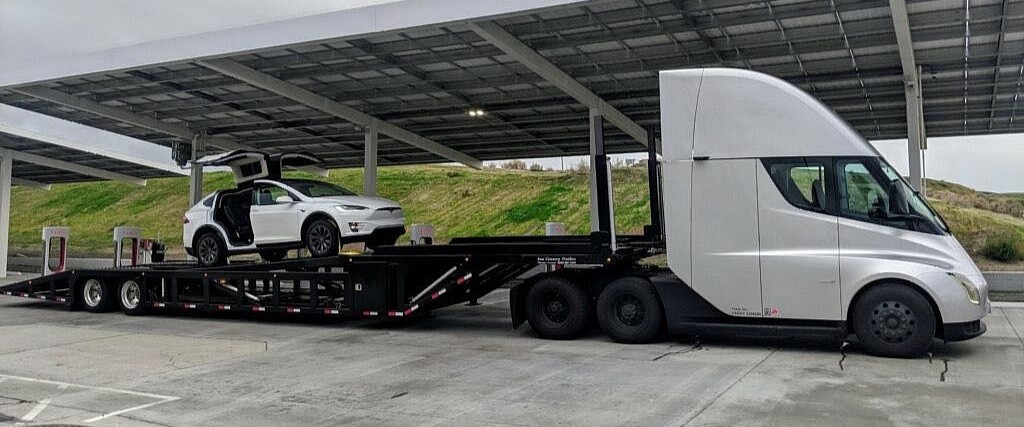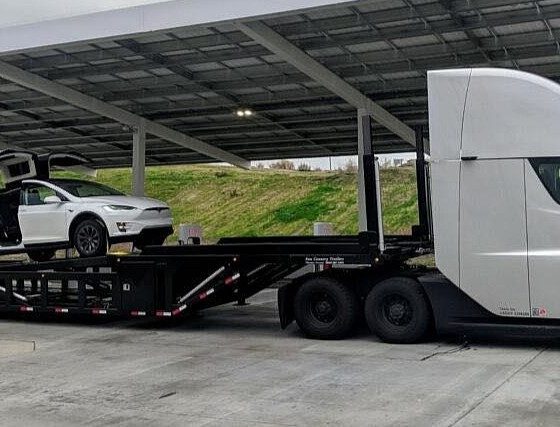

News
Tesla Semi with Model X in tow is an “aircraft carrier”, teases Jerome Guillen
In a rather rare social media post, Jerome Guillen, Tesla’s President of Automotive, shared an image of a vehicle that truly lies close to his heart — the Tesla Semi. The Automotive President’s post features the all-electric long-hauler parked at a Supercharger while pulling a trailer loaded with a Tesla Model X. Jerome even cleverly captioned his image with the words “Aircraft Carrier?” — a fun reference to the electric SUV’s open Falcon Wing Doors.
The recently-shared picture of the Tesla Semi was taken at the Kettleman City Supercharger, a site located between San Francisco and Los Angeles. The location is one of the United States’ largest Superchargers with 40 charging stalls, solar panel-equipped roofs, and a comfortable lounge for travelers stopping over to charge their vehicles. The site is also the same Supercharger where the red Tesla Semi prototype was sighted a few weeks back.
Since becoming Tesla’s President of Automotive last September, Guillen’s uploads of the all-electric long-hauler have become rather elusive. That said, his recently uploaded Tesla Semi post was certainly worth the wait, since the image could very well be the first picture of the upcoming electric truck with a completely new cargo and trailer.

The Tesla Semi is expected to be a vehicle that can disrupt the trucking market in the same way that the Model S and Model 3 are disrupting the full-size and mid-size sedan segments. The vehicle incited a lot of raised eyebrows when it was initially announced by CEO Elon Musk, thanks to its impressive specs that include a 300 to 500-mile range, a 0-60 mph time of 5 seconds flat, and four Model 3-derived electric motors. So disruptive were the Semi’s specs that Daimler Trucks boss Martin Daum infamously suggested that the Tesla Semi must be breaking the laws of physics.
Despite these reservations from critics though, the development of the Semi continued. Elon Musk has noted that improvements to the Semi are actively being done, even suggesting that the long-range variant of the all-electric truck could have closer to 600 miles of range per charge. Just recently, even the Daimler Trucks CEO, who dismissed the Semi in the past, acknowledged Tesla and the company’s tenacity. Daum still gave Tesla some warning about the lucrative and competitive trucking segment, though, stating that the business is far trickier than the consumer vehicle market.
“Tesla has proved they really have the tenacity to really go through huge losses to capture the market. But trucking is a difficult business. They will learn the hard way; trucking is not like passenger cars where one size fits all,” he said.
Inasmuch as Daum’s warnings are justified, the Tesla Semi is being developed with steady, experienced hands. Jerome Guillen, after all, has extensive experience in the trucking industry, and prior to his promotion as President of Automotive, he was personally heading the Semi program. Before to his employment at Tesla, Jerome served as the project leader for Daimler’s Freightliner Cascadia program as well, where he eventually became the head of the company’s Business Innovation unit. By the time he left for the electric car maker, Daimler’s Business Innovation unit was profitable and self-funding.
During the vehicle’s unveiling, Elon Musk noted that initial production of the vehicle will commence in 2019. That said, Eric Markowitz & Dan Crowley of Worm Capital stated in a note published after a tour of Gigafactory 1 that the electric car maker is planning on “earnestly” producing the Semi by 2020.

News
Tesla starts showing how FSD will change lives in Europe
Local officials tested the system on narrow country roads and were impressed by FSD’s smooth, human-like driving, with some calling the service a game-changer for everyday life in areas that are far from urban centers.

Tesla has launched Europe’s first public shuttle service using Full Self-Driving (Supervised) in the rural Eifelkreis Bitburg-Prüm region of Germany, demonstrating how the technology can restore independence and mobility for people who struggle with limited transport options.
Local officials tested the system on narrow country roads and were impressed by FSD’s smooth, human-like driving, with some calling the service a game-changer for everyday life in areas that are far from urban centers.
Officials see real impact on rural residents
Arzfeld Mayor Johannes Kuhl and District Administrator Andreas Kruppert personally tested the Tesla shuttle service. This allowed them to see just how well FSD navigated winding lanes and rural roads confidently. Kruppert said, “Autonomous driving sounds like science fiction to many, but we simply see here that it works totally well in rural regions too.” Kuhl, for his part, also noted that FSD “feels like a very experienced driver.”
The pilot complements the area’s “Citizen Bus” program, which provides on-demand rides for elderly residents who can no longer drive themselves. Tesla Europe shared a video of a demonstration of the service, highlighting how FSD gives people their freedom back, even in places where public transport is not as prevalent.
What the Ministry for Economic Affairs and Transport says
Rhineland-Palatinate’s Minister Daniela Schmitt supported the project, praising the collaboration that made this “first of its kind in Europe” possible. As per the ministry, the rural rollout for the service shows FSD’s potential beyond major cities, and it delivers tangible benefits like grocery runs, doctor visits, and social connections for isolated residents.
“Reliable and flexible mobility is especially vital in rural areas. With the launch of a shuttle service using self-driving vehicles (FSD supervised) by Tesla in the Eifelkreis Bitburg-Prüm, an innovative pilot project is now getting underway that complements local community bus services. It is the first project of its kind in Europe.
“The result is a real gain for rural mobility: greater accessibility, more flexibility and tangible benefits for everyday life. A strong signal for innovation, cooperation and future-oriented mobility beyond urban centers,” the ministry wrote in a LinkedIn post.
News
Tesla China quietly posts Robotaxi-related job listing
Tesla China is currently seeking a Low Voltage Electrical Engineer to work on circuit board design for the company’s autonomous vehicles.

Tesla has posted a new job listing in Shanghai explicitly tied to its Robotaxi program, fueling speculation that the company is preparing to launch its dedicated autonomous ride-hailing service in China.
As noted in the listing, Tesla China is currently seeking a Low Voltage Electrical Engineer to work on circuit board design for the company’s autonomous vehicles.
Robotaxi-specific role
The listing, which was shared on social media platform X by industry watcher @tslaming, suggested that Tesla China is looking to fill the role urgently. The job listing itself specifically mentions that the person hired for the role will be working on the Low Voltage Hardware team, which would design the circuit boards that would serve as the nervous system of the Robotaxi.
Key tasks for the role, as indicated in the job listing, include collaboration with PCB layout, firmware, mechanical, program management, and validation teams, among other responsibilities. The role is based in Shanghai.
China Robotaxi launch
China represents a massive potential market for robotaxis, with its dense urban centers and supportive policies in select cities. Tesla has limited permission to roll out FSD in the country, though despite this, its vehicles have been hailed as among the best in the market when it comes to autonomous features. So far, at least, it appears that China supports Tesla’s FSD and Robotaxi rollout.
This was hinted at in November, when Tesla brought the Cybercab to the 8th China International Import Expo (CIIE) in Shanghai, marking the first time that the autonomous two-seater was brought to the Asia-Pacific region. The vehicle, despite not having a release date in China, received a significant amount of interest among the event’s attendees.
Elon Musk
Elon Musk and Tesla AI Director share insights after empty driver seat Robotaxi rides
The executives’ unoccupied tests hint at the rapid progress of Tesla’s unsupervised Robotaxi efforts.

Tesla CEO Elon Musk and AI Director Ashok Elluswamy celebrated Christmas Eve by sharing personal experiences with Robotaxi vehicles that had no safety monitor or occupant in the driver’s seat. Musk described the system’s “perfect driving” around Austin, while Elluswamy posted video from the back seat, calling it “an amazing experience.”
The executives’ unoccupied tests hint at the rapid progress of Tesla’s unsupervised Robotaxi efforts.
Elon and Ashok’s firsthand Robotaxi insights
Prior to Musk and the Tesla AI Director’s posts, sightings of unmanned Teslas navigating public roads were widely shared on social media. One such vehicle was spotted in Austin, Texas, which Elon Musk acknowleged by stating that “Testing is underway with no occupants in the car.”
Based on his Christmas Eve post, Musk seemed to have tested an unmanned Tesla himself. “A Tesla with no safety monitor in the car and me sitting in the passenger seat took me all around Austin on Sunday with perfect driving,” Musk wrote in his post.
Elluswamy responded with a 2-minute video showing himself in the rear of an unmanned Tesla. The video featured the vehicle’s empty front seats, as well as its smooth handling through real-world traffic. He captioned his video with the words, “It’s an amazing experience!”
Towards Unsupervised operations
During an xAI Hackathon earlier this month, Elon Musk mentioned that Tesla owed be removing Safety Monitors from its Robotaxis in Austin in just three weeks. “Unsupervised is pretty much solved at this point. So there will be Tesla Robotaxis operating in Austin with no one in them. Not even anyone in the passenger seat in about three weeks,” he said. Musk echoed similar estimates at the 2025 Annual Shareholder Meeting and the Q3 2025 earnings call.
Considering the insights that were posted Musk and Elluswamy, it does appear that Tesla is working hard towards operating its Robotaxis with no safety monitors. This is quite impressive considering that the service was launched just earlier this year.








